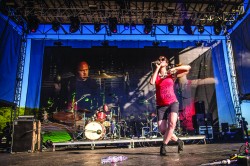Music | July 22nd, 2015

In 2008, Justin Vernon was known best, if at all, for the icy falsetto that blew through “For Emma, Forever Ago.” That album, released under the nom de band Bon Iver (appropriately translating to “good winter” in broken French), shot the songwriter to the fore with its “Walden”-esque creation story and the haunting beauty of songs like “Skinny Love.” Since then, Vernon’s appetite for creation has been relentless, leading the once-isolated musician to features with Kanye West, a bevy of side project releases ranging from blues-rock to post-everything experimentation, and production credits for such disparate projects as the Staves and the Blind Boys of Alabama.
Driven by a distinctly Midwestern work ethic, Vernon’s collaborative aptitude has yielded not only a dizzyingly diversified portfolio, but a rich genealogy of artists rooted in his patriarchy. In undertaking the inaugural Eaux Claires festival, Vernon tapped this extended musical family for a two-day gathering just outside of his namesake hometown, alternately celebrating his partners and the beautiful, wooded land that initially inspired him.
Nestled by the slow drift of the Chippewa River and the thick Wisconsin woods, the festival grounds were of pastoral beauty. Adjoined by a thin dirt trail, the grounds were divided into two grassy tracts: the larger expanse flanked by alternating main stages and speckled with food and beer vendors, water fountains and a children’s area, the smaller marked by a massive, tented stage and several half-domed art installations. All the while, miniature parades, art performances and sideshows buzzed constantly on the peripheries for more exploratory festival-goers.
While other, larger festivals often have as many as four stages blaring at any given time, the decision to have only two simultaneously live stages was a boon, rather than a drawback, to Eaux Claires. This setup ensured that each artist, no matter their prominence or popularity, played to roughly half of the festival’s 22,000 attendees – a consideration that paralleled the organizers’ thoughtful alphabetization of the lineup on all posters and merchandise rather than segregating acts through tiers of descending font sizes.
Gestures such as these were not lost on the forty-one performers that spread themselves across the two-day festival. Almost every act I saw gave a heartfelt acknowledgment of gratitude to Vernon for his invitation. Awash in their goofball modesty, the members of Wisconsin’s sweetheart band PHOX were left speechless at the opportunity to play for thousands on their own turf. Sufjan Stevens, after admitting his anxiety towards festivals, likened the festival to a “48-hour episode of ‘My Little Pony.’” Just a few songs deep into their thumping set and speaking to the overflowing Dells of the St. Croix tent, Sylvan Esso’s Nick Sanborn was quick to praise the festival as the best that the duo had ever played, thanking Vernon for organizing a festival that existed solely for the purpose of music.
This sentiment, which was met with uproarious applause, clearly resonated with the wristbanded masses. The dreaded staples of established festivals – cooler-than-thou uber hipsters, saucer-eyed molly-gobblers, three-story bags of Doritos® towering over the stages – were nowhere in sight at Eaux Claires. Chalk it up to Midwestern politeness, but even the typical “my friend is up there” elbowing to the front rows was a rare event.
The most exciting aspect of the festival came in the form of the surprise collaborations that speckled the acts. Sylvan Esso’s Amelia Meath sang sassy backup for Phil Cook until handing over the mic for a cameo appearance by Indigo Girls’ Amy Ray as the band launched into a spirited cover of CCR’s “Lodi.” Bon Iver’s S. Carey, during his own Saturday set, was joined by the UW-Eau Claire jazz ensemble, which lent his spare sound a thrillingly arranged fullness. The climax of the festival, and the supposed last concert of theirs before an indefinite hiatus, a triumphant Bon Iver burned through an hour and a half set, muscling up their best-known songs and premiering two new ones. Joined intermittently by the Staves, Colin Stetson, the National’s Aaron and Bryce Dessner, yMusic and the festival’s titanic No BS! Brass Band, Bon Iver’s finale was a euphoric cap to a near-perfect weekend of music and nothing but.
Such large-scale events, especially on their first go-round, are bound to have a few kinks, however. I can’t help but feel a bit jilted for missing Friday’s opener, Hiss Golden Messenger, because of an unexpected hour-and-a-half wait to turn my paper ticket into a wristband, especially when it became apparent that there were only five or six people, armed with hopelessly faulty scanners, processing the thousands of waiting fans. Long lines plagued the festival’s two inadequate water stations, and those looking to grab some cheese curds or artisan pizza were soon lost to a crowd clustered by food tents and trucks too tightly conjoined for any semblance of proper lines to form. And while most sets were marked by astonishingly clear mixes, only the Blind Boys of Alabama could have overcome the booms and hisses of mysterious feedback that cropped up during their revival tent revue.
These complaints, though, are picked nits in the shadow of all that was done so right by Vernon and all of the other fine folks behind the Eaux Claires festival. Right down to the sleek field notes journals handed out to each incoming attendee, filled with daily schedules, a festival map, and brief, poetic descriptions of each artist, it was clear that the event was deeply purposeful. One can only hope that Justin Vernon, in the spirit of most family reunions, will make the Eaux Claires gathering an annual occurrence.
September 16th 2025
August 19th 2025
June 9th 2025
February 18th 2025
November 13th 2024
_(1)__293px-wide.jpg)
__293px-wide.jpg)
_(1)__293px-wide.png)
_(1)_(1)_(1)__293px-wide.jpg)

_(1)_(1)_(1)__293px-wide.jpg)